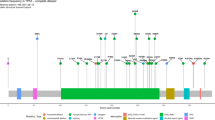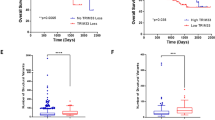Abstract
Hemizygous deletion of 17p13, which harbors the TP53 gene, has been identified in >10% of newly diagnosed multiple myeloma (MM) patients and is associated with poor prognosis. To date, there is no conclusive evidence that TP53 is the critical gene. Furthermore, the functional effect of TP53 haploinsufficiency is not well characterized. By utilizing human myeloma cell lines, we showed that TP53 hemizygous loss was associated with decreased basal expression level with a partially or severely inactivated p53 response upon genotoxic and non-genotoxic stress. The pathway deficiency was manifested as defective p53 transcriptional activities, together with significant resistance to apoptosis. In some cases with p53 WT/− and no p53 protein expression, the remaining allele was silenced by promoter hypermethylation. We also developed a p53 target gene signature to summarize the complexity of the p53 pathway abnormalities in MM and showed that it is strongly associated with genomic complexity and patient survival. In conclusion, this study identified TP53 as the critical gene located in 17p13, and revealed its haploinsufficiency properties in MM. Furthermore, we have elucidated that multiple mechanisms can deregulate the p53 functions and that this has important prognostic impact in MM.
This is a preview of subscription content, access via your institution
Access options
Subscribe to this journal
Receive 12 print issues and online access
$259.00 per year
only $21.58 per issue
Buy this article
- Purchase on Springer Link
- Instant access to full article PDF
Prices may be subject to local taxes which are calculated during checkout








Similar content being viewed by others
References
Stühmer T, Chatterjee M, Hildebrandt M, Herrmann P, Gollasch H, Gerecke C et al. Nongenotoxic activation of the p53 pathway as a therapeutic strategy for multiple myeloma. Blood 2005; 106: 3609–3617.
Yuregir OO, Sahin FI, Yilmaz Z, Kizilkilic E, Karakus S, Ozdogu H . Fluorescent in situ hybridization studies in multiple myeloma. Hematology 2009; 14: 90–94.
Saha MN, Jiang H, Jayakar J, Reece D, Branch DR, Chang H . MDM2 antagonist nutlin plus proteasome inhibitor velcade combination displays a synergistic anti-myeloma activity. Cancer Biol Ther 2010; 9: 937–945.
Drach J, Ackermann J, Fritz E, Kromer E, Schuster R, Gisslinger H et al. Presence of a p53 gene deletion in patients with multiple myeloma predicts for short survival after conventional-dose chemotherapy. Blood 1998; 92: 802–809.
Vogelstein B, Lane D, Levine AJ . Surfing the p53 network. Nature 2000; 408: 307–310.
Vousden KH, Lu X . Live or let die: the cell's response to p53. Nat Rev Cancer 2002; 2: 594–604.
Chng WJ, Price-Troska T, Gonzalez-Paz N, Van Wier S, Jacobus S, Blood E et al. Clinical significance of TP53 mutation in myeloma. Leukemia 2007; 21: 582–584.
Lode L, Eveillard M, Trichet V, Soussi T, Wuilleme S, Richebourg S et al. Mutations in TP53 are exclusively associated with del(17p) in multiple myeloma. Haematologica 2010; 95: 1973–1976.
Boyd KD, Ross FM, Tapper WJ, Chiecchio L, Dagrada G, Konn ZJ et al. The clinical impact and molecular biology of del(17p) in multiple myeloma treated with conventional or thalidomide-based therapy. Genes Chromosome Cancer 2011; 50: 765–774.
Fonseca R, Blood E, Rue M, Harrington D, Oken MM, Kyle RA et al. Clinical and biologic implications of recurrent genomic aberrations in myeloma. Blood 2003; 101: 4569–4575.
Chen MH, Qi CXY, Saha MN, Chang H . p53 nuclear expression correlates with hemizygous TP53 deletion and predicts an adverse outcome for patients with relapsed/refractory multiple myeloma treated with lenalidomide. Am J Clin Pathol 2012; 137: 208–212.
Chapman MA, Lawrence MS, Keats JJ, Cibulskis K, Sougnez C, Schinzel AC et al. Initial genome sequencing and analysis of multiple myeloma. Nature 2011; 471: 467–472.
Barrett T, Wilhite SE, Ledoux P, Evangelista C, Kim IF, Tomashevsky M et al. NCBI GEO: archive for functional genomics data sets–update. Nucleic Acids Res 2012; 41: D991–D995.
Pruitt KD, Tatusova T, Brown GR, Maglott DR . NCBI Reference Sequences (RefSeq): current status, new features and genome annotation policy. Nucleic Acids Res 2011; 40: D130–D135.
Chmelarova M, Krepinska E, Spacek J, Laco J, Beranek M, Palicka V . Methylation in the p53 promoter in epithelial ovarian cancer. Clin Trans Oncol 2012; 15: 160–163.
Chng WJ, Huang GF, Chung TH, Ng SB, Gonzalez-Paz N, Troska-Price T et al. Clinical and biological implications of MYC activation: a common difference between MGUS and newly diagnosed multiple myeloma. Leukemia 2011; 25: 1026–1035.
Zhan F, Huang Y, Colla S, Stewart JP, Hanamura I, Gupta S et al. The molecular classification of multiple myeloma. Blood 2006; 108: 2020–2028.
Broyl A, Hose D, Lokhorst H, de Knegt Y, Peeters J, Jauch A et al. Gene expression profiling for molecular classification of multiple myeloma in newly diagnosed patients. Blood 2010; 116: 2543–2553.
Mulligan G, Mitsiades C, Bryant B, Zhan F, Chng WJ, Roels S et al. Gene expression profiling and correlation with outcome in clinical trials of the proteasome inhibitor bortezomib. Blood 2007; 109: 3177–3188.
Goh AM, Coffill CR, Lane DP . The role of mutant p53 in human cancer. J Pathol 2011; 223: 116–126.
Liu DP, Song H, Xu Y . A common gain of function of p53 cancer mutants in inducing genetic instability. Oncogene 2010; 29: 949–956.
Lynch CJ, Milner J . Loss of one p53 allele results in four-fold reduction of p53 mRNA and protein: a basis for p53 haplo-insufficiency. Oncogene 2006; 25: 3463–3470.
Saha MN, Jiang H, Chang H . Molecular mechanisms of nutlin-induced apoptosis in multiple myeloma: evidence for p53-transcription-dependent and -independent pathways. Cancer Biol Ther 2010; 10: 567–578.
Saha MN, Micallef J, Qiu LG, Chang H . Pharmacological activation of the p53 pathway in haematological malignancies. J Clin Pathol 2010; 63: 204–209.
Xiong W, Wu XS, Starnes S, Johnson SK, Haessler J, Wang SQ et al. An analysis of the clinical and biologic significance of TP53 loss and the identification of potential novel transcriptional targets of TP53 in multiple myeloma. Blood 2008; 112: 4235–4246.
Kuiper R, Broyl A, de Knegt Y, van Vliet MH, van Beers EH, van der Holt B et al. A gene expression signature for high-risk multiple myeloma. Leukemia 2012; 26: 2406–2413.
Hodge DR, Peng B, Cherry JC, Hurt EM, Fox SD, Kelley JA et al. Interleukin 6 supports the maintenance of p53 tumor suppressor gene promoter methylation. Cancer Res 2005; 65: 4673–4682.
Chim CS, Kwong YL, Liang R . Gene hypermethylation in multiple myeloma: lessons from a cancer pathway approach. Clin Lymphoma Myeloma 2008; 8: 331–339.
Kaiser MF, Johnson DC, Wu P, Walker BA, Brioli A, Mirabella F et al. Global methylation analysis identifies prognostically important epigenetically inactivated tumor suppressor genes in multiple myeloma. Blood 2013; 122: 219–226.
Chang H, Qi C, Yi QL, Reece D, Stewart AK . p53 gene deletion detected by fluorescence in situ hybridization is an adverse prognostic factor for patients with multiple myeloma following autologous stem cell transplantation. Blood 2005; 105: 358–360.
Chang H, Sloan S, Li D, Keith Stewart A . Multiple myeloma involving central nervous system: high frequency of chromosome 17p13.1 (p53) deletions. Br J Haematol 2004; 127: 280–284.
Ohnstad HO, Castro R, Sun J, Heintz KM, Vassilev LT, Bjerkehagen B et al. Correlation of TP53 and MDM2 genotypes with response to therapy in sarcoma. Cancer 2013; 119: 1013–1022.
Okamoto H, Fujishima F, Nakamura Y, Zuguchi M, Miyata G, Kamei T et al. Murine double minute 2 and its association with chemoradioresistance of esophageal squamous cell carcinoma. Anticancer Res 2013; 33: 1463–1471.
Shangary S, Wang S . Targeting the MDM2-p53 interaction for cancer therapy. Clin Cancer Res 2008; 14: 5318–5324.
Tovar C, Rosinski J, Filipovic Z, Higgins B, Kolinsky K, Hilton H et al. Small-molecule MDM2 antagonists reveal aberrant p53 signaling in cancer: Implications for therapy. Proc Natl Acad Sci U SA 2006; 103: 1888–1893.
Hanel W, Moll UM . Links between mutant p53 and genomic instability. J Cell Biochem 2012; 113: 433–439.
Brusa G, Benvenuti M, Mazzacurati L, Mancini M, Pattacini L, Martinelli G et al. p53 loss of function enhances genomic instability and accelerates clonal evolution of murine myeloid progenitors expressing the p(210)BCR-ABL tyrosine kinase. Haematologica 2003; 88: 622–630.
Elnenaei MO, Gruszka-Westwood AM, A'Hernt R, Matutes E, Sirohi B, Powles R et al. Gene abnormalities in multiple myeloma; the relevance of TP53, MDM2, and CDKN2A. Haematologica 2003; 88: 529–537.
Venkatachalam S, Tyner S, Pickering C, Boley S, Recio L, French J et al. Is p53 Haploinsufficient for tumor suppression? Implications for the p53 +/− mouse model in carcinogenicity testing. Toxicol Pathol 2001; 29: 147–154.
Venkatachalam S, Shi YP, Jones SN, Vogel H, Bradley A, Pinkel D et al. Retention of wild-type p53 in tumors from p53 heterozygous mice: reduction of p53 dosage can promote cancer formation. EMBO J 1998; 17: 4657–4667.
Clarke AR, Purdie CA, Harrison DJ, Morris RG, Bird CC, Hooper ML et al. Thymocyte apoptosis induced by p53-dependent and independent pathways. Nature 1993; 362: 849–852.
Xiong W, Zhan FH, Huang YS, Barlogie B, Shaughnessy JD . TP53 gene expression, correlated with 17p13 deletion, is a significant and independent adverse prognostic factor in multiple myeloma treated with high-dose therapy and auto-transplants. Blood 2006; 108: 3394.
Braggio E, Maiolino A, Gouveia ME, Magalhaes R, Souto Filho JT, Garnica M et al. Methylation status of nine tumor suppressor genes in multiple myeloma. Int J Hematol 2010; 91: 87–96.
Gonzalez M, Mateos MV, Garcia-Sanz R, Balanzategui A, Lopez-Perez R, Chillon MC et al. De novo methylation of tumor suppressor gene p16/INK4a is a frequent finding in multiple myeloma patients at diagnosis. Leukemia 2000; 14: 183–187.
Chim CS, Kwong YL, Fung TK, Liang R . Methylation profiling in multiple myeloma. Leuk Res 2004; 28: 379–385.
Galm O, Wilop S, Reichelt J, Jost E, Gehbauer G, Herman JG et al. DNA methylation changes in multiple myeloma. Leukemia 2004; 18: 1687–1692.
Hurt EM, Thomas SB, Peng B, Farrar WL . Reversal of p53 epigenetic silencing in multiple myeloma permits apoptosis by a p53 activator. Cancer Biol Ther 2006; 5 (9): 1154–1160.
Pichiorri F, Suh SS, Rocci A, De Luca L, Taccioli C, Santhanam R et al. Downregulation of p53-inducible microRNAs 192, 194, and 215 impairs the p53/MDM2 autoregulatory loop in multiple myeloma development. Cancer Cell 2010; 18: 367–381.
Teoh G, Urashima M, Ogata A, Chauhan D, DeCaprio JA, Treon SP et al. MDM2 protein overexpression promotes proliferation and survival of multiple myeloma cells. Blood 1997; 90: 1982–1992.
Saha MN, Jayakar J, Chang H . Nutlin-3 and Velcade synergistically induce cell cycle arrest and apoptosis in multiple myeloma through activation of p53 pathway. Modern Pathol 2009; 22: 1287.
Acknowledgements
WJC is supported by NMRC Clinician Scientist Investigator award. This work is partly supported by Singapore Cancer Syndicate Grant. This research is supported by the National Research Foundation Singapore and the Singapore Ministry of Education under the Research Centers of Excellence initiative. Rafael Fonseca is a Clinical Investigator of the Damon Runyon Cancer Research Fund. This work is supported by grants SPORE CA90297052, P01 CA62242, R01 CA83724, ECOG CA 21115 T, Predolin Foundation, Mayo Clinic Cancer Center and the Mayo Foundation.
Author information
Authors and Affiliations
Corresponding author
Ethics declarations
Competing interests
The authors declare no conflict of interest.
Additional information
Supplementary Information accompanies this paper on the Leukemia website
Supplementary information
Rights and permissions
About this article
Cite this article
Teoh, P., Chung, T., Sebastian, S. et al. p53 haploinsufficiency and functional abnormalities in multiple myeloma. Leukemia 28, 2066–2074 (2014). https://doi.org/10.1038/leu.2014.102
Received:
Revised:
Accepted:
Published:
Issue Date:
DOI: https://doi.org/10.1038/leu.2014.102
This article is cited by
-
Identifying novel mechanisms of biallelic TP53 loss refines poor outcome for patients with multiple myeloma
Blood Cancer Journal (2023)
-
Survival prediction and treatment optimization of multiple myeloma patients using machine-learning models based on clinical and gene expression data
Leukemia (2021)
-
Assessment of TP53 lesions for p53 system functionality and drug resistance in multiple myeloma using an isogenic cell line model
Scientific Reports (2019)
-
Natural history of multiple myeloma with de novo del(17p)
Blood Cancer Journal (2019)
-
Growth factor independence 1 expression in myeloma cells enhances their growth, survival, and osteoclastogenesis
Journal of Hematology & Oncology (2018)



